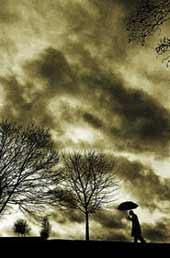Broken seesaw warms North

Wetter winters could be forecast months ahead. <br>© ImageSource <br>
American Geophysical Society Meeting, San Francisco, December 2001
Pressure system secrets could help long range forecasts.
The rise in levels of greenhouse gases has halted an oscillation of air pressures over the Arctic, bringing warmer, wetter winters to Northern Europe, Siberia and Alaska. The shift could get worse with increasing CO2 emissions, delegates heard this week at the American Geophysical Union meeting in San Francisco, California.
The trend is unlikely to have a natural cause, Nathan Gillett, a climate modeller at the University of Oxford in the UK, told the conference. “It is consistent with most climate models’ response to greenhouse gases,” he added.
But the cloudy winter skies over Europe may have a silver lining. Identifying the effects of the Arctic oscillation (AO) could one day enable researchers to forecast aspects of northern hemisphere weather months, even seasons ahead of time.
Like El Nino, the AO is a variation in atmospheric pressure. It seesaws between Iceland at one end and Spain and Portugal at the other. The AO’s negative phase brings higher-than-normal pressure to the polar region and lower pressure to Eurasia and North America. The positive phase brings the opposite: warmer, wetter weather to northern regions and dryer conditions to lower latitudes.
Scientists used to think that the AO was completely random. But in 1995 James Hurrell of the National Center for Atmospheric Research in Boulder, Colorado, showed that it actually follows a 10-year cycle and that since the 1980s the seesaw has been stuck in its positive phase1. “This has an impact on winter surface temperatures,” says Hurrell.
Recent estimates suggest that the skewed AO may account for half of the warmer winter episodes and rainfall in northern Atlantic areas such as Scotland.
Working with the computer models used to forecast Britain’s weather, Gillett calculated the impact of a doubling of atmospheric CO2 levels (expected to happen by about 2040) on the AO’s intensity. He found that the additional CO2 would keep the AO in its positive phase and strengthen its effects.
Most experts agree that the skewed AO is probably caused by greenhouse gases, according to climatologist John Wallace at the University of Washington in Seattle. Although he cautions that climate models are never perfect.
High cycle
What happens to the AO in the absence of man-made perturbations, on the other hand, is open to debate. One suggestion is that increasing tropical ocean temperatures cause the phenomenon. Another proposes that long-term cycles high in the stratosphere, six to thirty miles above the Earth, are driving it.
New evidence presented at the meeting by Mark Baldwin, of Northwest Research Associates in Bellevue, Washington, suggests that fluctuations in the stratosphere’s thickness are linked to the AO.
Although the effects of the stratosphere will still be amplified by an increase in greenhouse gases, the finding is otherwise good news, says Wallace, because the frequency of the waves are known. “These stratosphere waves could make 60-day forecasts possible,” he says.
What’s more, longer-term fluctuations in tropical Atlantic temperature contribute to the power of stratospheric waves, so it should be possible to predict weather seasons in advance, says Wallace. “One day we might be predicting the likelihood of a certain number of cold snaps in the coming year,” he says.
References
- Hurrell, J. W. Decadal trends in the North Atlantic Oscillation: regional temperatures and precipitation. Science, 269, 676 – 679, (1995).
Media Contact
More Information:
http://www.nature.com/nsu/011213/011213-11.htmlAll latest news from the category: Earth Sciences
Earth Sciences (also referred to as Geosciences), which deals with basic issues surrounding our planet, plays a vital role in the area of energy and raw materials supply.
Earth Sciences comprises subjects such as geology, geography, geological informatics, paleontology, mineralogy, petrography, crystallography, geophysics, geodesy, glaciology, cartography, photogrammetry, meteorology and seismology, early-warning systems, earthquake research and polar research.
Newest articles

First-of-its-kind study uses remote sensing to monitor plastic debris in rivers and lakes
Remote sensing creates a cost-effective solution to monitoring plastic pollution. A first-of-its-kind study from researchers at the University of Minnesota Twin Cities shows how remote sensing can help monitor and…

Laser-based artificial neuron mimics nerve cell functions at lightning speed
With a processing speed a billion times faster than nature, chip-based laser neuron could help advance AI tasks such as pattern recognition and sequence prediction. Researchers have developed a laser-based…

Optimising the processing of plastic waste
Just one look in the yellow bin reveals a colourful jumble of different types of plastic. However, the purer and more uniform plastic waste is, the easier it is to…



